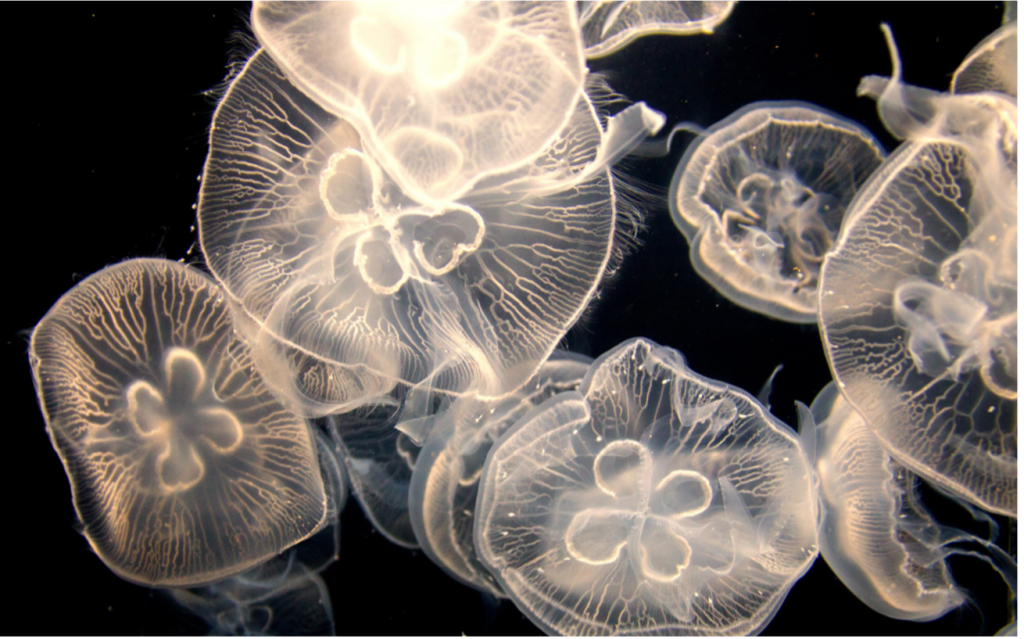As dense aggregations of moon jellyfish form in Puget Sound, researchers study the ecosystem-wide impacts
By Andrea Richter-Sanchez, WSG Science Communications Fellow

Photo: Shutterstock
Have you ever seen a jellyfish floating in Puget Sound? Chances are, it was a moon jellyfish. Moon jellies, or Aurelia labiata have had large blooms — high numbers in certain areas — in the past several years.
Moon jelly aggregations normally form in the summer in Puget Sound. However, researchers started to notice an intensification of the blooms after the marine heat wave in 2015-2016. The heat wave not only coincided with higher aggregations, but the aggregations persisted for a longer period of time. Moon jellies are carnivorous, and eat tiny zooplankton including the larvae of mollusks, crustaceans and small fishes. Researchers wondered whether the increase in moon jelly abundance is altering the ecosystem as the “jellies” gobble up the zooplankton in Puget Sound. With funding from Washington Sea Grant, Haila Schultz — a doctoral student in oceanography at the University of Washington (UW) — set out to study these potential impacts.
To start off the project, Schultz collaborated with Rus Higley, director of Highline College’s Marine Science and Technology (MaST) center. Schultz used the center’s water tanks for the lab component of her research. Each water tank was set up to have a different number of moon jellies inside. They put the same amount of zooplankton, a primary food source for moon jellies, in each tank. They chose copepods, which are a type of zooplankton that are prevalent in Puget Sound. In each tank, the moon jellies ate copepods for a total of two hours. The water was then drained from the tanks in order to collect the remaining copepods. Results showed that in the tanks with a lot of moon jellies, up to 75% of copepods were consumed.
After completing the preliminary lab work, Schultz was ready to go into the field to test whether her lab results would mimic what happens in the real world. In addition to Schultz’s advisor, Julie Keister, who is an affiliate at the UW School of Oceanography and program manager at NOAA, both Correigh Greene from NOAA Northwest Fisheries Science Center and Kathryn Sobocinski from Western Washington University were collaborators who helped design the project. The field work was completed in two embayments with moon jellies: Quartermaster Harbor in Vashon Island and Sinclair inlet near Bremerton. They also took samples in inlets with no moon jellies: Budd inlet and Eld inlet. They dropped a CTD — an instrument that collects data on temperature, fluorescence, oxygen, pH, and salinity — in the water to sample the water chemistry inside and outside the aggregations. Nutrients were also measured from all the water samples collected.
Zooplankton are a crucial component in aquatic food webs because they control phytoplankton populations, and they transfer energy from primary producers such as phytoplankton to higher trophic levels like fish. Schultz found that there were significantly fewer copepods in areas with moon jellies, which confirms what her previous lab work found. This coincided with increased phytoplankton in areas with moon jellies, indicating a possible trophic cascade where increased jellyfish predation on zooplankton led to decreased zooplankton predation on phytoplankton. The jellyfish inlets also had different phytoplankton communities and higher levels of nitrate and nitrite than the non-jellyfish inlets. They speculate that the differences in nutrients could be due to the nitrogenous waste that is released into the water by jellyfish. Bacteria then converts that waste into nitrite and nitrate — two essential nutrients for phytoplankton.
Schultz wanted to test the influence that other environmental factors may have on copepod densities and compare those to moon jelly aggregation effects. She did this by setting up a model that included different environmental factors such as temperature and chlorophyll, both proxies for phytoplankton. The results showed that moon jelly abundance was still the number one variable to affect copepod densities.
What is causing this increase in jellyfish? “This phenomenon appears to be happening all over the world, but its cause and magnitude is still a debate among scientists,” Schultz says. One theory has to do with urban development. When moon jellies are in the polyp stage, they have to attach to a structure to reproduce. Evidence has shown that they prefer man-made structures like piers and docks. As we change the marine landscape by adding more structures, we are increasing their reproduction rates.
Schultz’s work will be added to NOAA’s Atlantis Ecosystem model for Puget Sound. At the NOAA Northwest Fisheries Science Center, researchers Hem Nalini Morzaria-Luna and Isaac Kaplan will be using the results of this project to update the jellyfish parameter in the Atlantis Ecosystem Model. This research will improve the jellyfish parameters of that model and be used to determine how fish populations are affected by these blooms and what kind of impacts moon jellies may have on food web dynamics in Puget Sound.
“Jellyfish are not necessarily bad, but we want to keep an eye on them to see what their potential effects could be,” Schultz says.
www.wsg.uw.edu
Join the conversation: @WASeaGrant and Facebook.com/WaSeaGrant.
JUN
2023